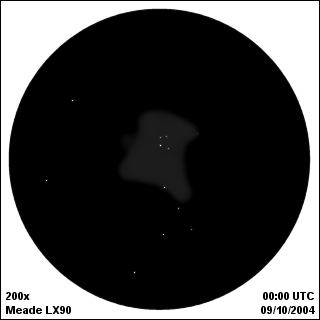| cosam.org |
Observation Log - 09/10/2004
| Subject: | Various DSOs, Saturn |
| Seeing: | Good |
| Light: | Poor |
| Location: | Home (front landing) |
Equipment
| Scope: | Meade LX90 |
Comments
After another long wait for decent weather, this nice clear night was a very welcome change. Seeing was good, transparency too, down to around 15-20 degrees. Limiting visual magnitude varied, but must've been around 5 at best as the seven brightest stars of the Pleiades were all visible with a bit of effort - quite impressive for this location. The last couple of times, I've actually set up just inside the doorway. Tonight, I ventured out onto the landing. This is a real trade-off situation as inside it's acually quite dark, whereas outside there are a lot of very bright flourescent lights. Dark adaption is virtually impossible, but the total field of view is of course far, far greater. Given such conditions, obersvation was surprisingly satisfying!
I aligned the scope on Capella and Mizar, the latter of which I spent a couple of minutes viewing, as it's a nice double. I then slewed back over to Auriga to checked out the open clusters M36, M37 and M38. Given that I was litterally bathed in light, I was able to see these objects very well. A small reference book I have said that these clusters consist of around 60, 150 and 100 stars respectively, and I'd estimate I was able to resolve at least 1/2 to 3/4 of them.
Back over in Ursa Major, I observed the galaxies M81 and M82. Both seemed reasonably bright, and were very easily distinguishable from neighbouring stars. M81 was obviously circular in form, with a bright centre fading gradually into the background sky. M82, on the other hand, was more cigar-shaped and the bright center seemed similarly elongated when compared to that of M81. These are the first galaxies I've observed telescopically and actually recognised as such, so even thought detail was limited, it was still a very exciting moment!
My old favourite, Saturn would be rising about now, so I thought I'd take a look in that direction. Surprisingly the rings were visible when the planet was a mere 5 degrees from the horizon! Detail was however completely obliterated by the thick atmosphere. Whilst in the area, I moved on up to NGC 2392, the Eskimo Nebula. I got a most impressive view considering it was so low in the sky, but not much more than a faint blob. Another object I'll be adding to the list of things to try again when it's better positioned.
As mentioned before, M45, the Pleiades, was very clearly visible with the naked eye - a little squinting and averted vision would reveal the plough-shaped form of the seven brightest stars. The view from the LX90's finder was already impressive; the surrounding stars seemed to make the whole region glow (although I'm assuming this was more an effect of the Earth's atmosphere than any nebulosity lurking between the stars). I had a quick scan around through the main scope, but my longing for a small, wide-field scope is getting worse every time I look at this kind of object!
Orion had been peeking over the horizon for a while now, and was starting to climb into a more viewable position. Time then, I though, to check out M42: the Great Orion Nebula. Eventhough it was located just above a very well-lit apartment building or two, the outline of the visible part of the nebula was very clearly defined, as shown in the sketch below. Starting out at around 77x, bumping up the magnification to around 200x didn't result in any noticable loss of detail. Having looked forward to seeing this object for some time, it was great to finally get a good view of it.
 Eyepiece sketch of M42, the Great Orion Nebula |
At this stage, the cold of the night started to bite and I retreated indoors. As usual, I had to have a peek out of the window at the other end of the apartment! And, as usual, transparency and sky glow were noticably worse here. I did however manage to get a peek at M31, the Andromeda Galaxy, through the LX90's finder by perching in a very precarious position on the window ledge. In the interests of self-preservation and getting some sleep, I finally turned in around 2:30am.